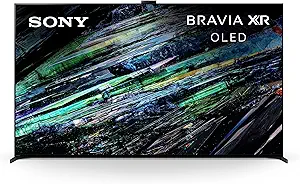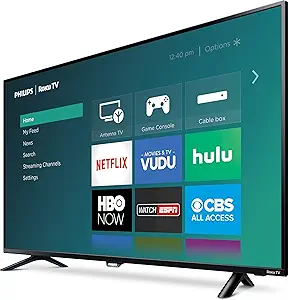
Choosing the right television is no simple task, especially when it comes to two industry giants like Sony and Philips. With Sony’s reputation for cutting-edge technology and premium performance, and Philips’ focus on affordability and unique innovations, both brands cater to distinct audiences. This in-depth comparison will guide you through every crucial aspect to help you make the best decision for your needs.
Sony and Philips have long been at the forefront of TV technology. Sony is celebrated for its groundbreaking QD-OLED displays, Cognitive Processor XR, and overall premium build quality. Philips, on the other hand, offers exceptional value through its budget-friendly options and unique features like Ambilight. In this article, we compare both brands across affordability, picture quality, design, sound, performance, smart features, and more to help you make an informed decision tailored to your needs and budget.
Key Features Comparison
Affordability
Sony targets mid-range to premium buyers, reflected in its pricing strategy. Entry-level models such as the W830K is priced $300, providing accessible options with quality assured by the Sony brand. On the other hand, flagship models like the BRAVIA XR A95L and Bravia 9 range from $2,500 to $10,000, incorporating cutting-edge technologies such as QD-OLED panels and the Cognitive Processor XR, which utilize quantum dot technology to enhance brightness and color volume. These technologies justify the premium pricing by delivering unmatched visual fidelity and longevity, making Sony a choice for enthusiasts who demand the best.

Philips excels in affordability, catering to budget-conscious consumers with models starting at $200, such as the 4500 Series LED LCD. For those seeking mid-range options, the 7900 Series QLED Roku combine vibrant visuals with innovative features like Ambilight, priced between $800 and $2,000. Philips’ competitive pricing ensures buyers have access to advanced features such as Variable Refresh Rate (VRR) and Dolby Atmos, offering cost-effective performance for everyday use.

Philips wins in affordability by offering more budget-friendly options with substantial value. Sony justifies its higher prices with premium performance and advanced technologies, ideal for long-term value and cutting-edge features.
Picture Quality
Top-Rated Picture Quality Brands
Sony is renowned for its industry-leading QD-OLED technology, showcased in the BRAVIA XR A95L, which delivers exceptional brightness, color accuracy, and deep contrast. This technology combines Quantum Dot Enhancement with OLED’s perfect black levels to create unparalleled visual performance. Additionally, the Cognitive Processor XR analyzes and enhances each frame for optimal depth, detail, and realism, ensuring consistent picture quality across different content types. The BRAVIA 8, with its OLED display, excels in cinematic viewing, particularly in darker environments, by achieving infinite contrast and precise color reproduction. For LED enthusiasts, the BRAVIA XR X90L employs Full-Array Local Dimming (FALD) to enhance brightness and contrast, making it ideal for brighter spaces.

Philips offers impressive picture quality for its price range, particularly with models like the OLED Series Roku TV, which features 4K Ultra HD resolution and wide color gamut technology for vibrant visuals. These TVs excel in dimly lit settings, delivering deep blacks and high contrast. The 7900 Series QLED Roku integrates Quantum Dot Technology to produce vivid colors and is tailored for brighter environments. A unique advantage Philips brings to the table is its Ambilight technology, which projects dynamic colors onto the walls surrounding the TV, enhancing immersion and perceived contrast.

Sony leads with superior picture quality, driven by advanced QD-OLED technology and powerful processing. Philips provides excellent visual performance with unique features like Ambilight, catering to budget-conscious buyers seeking an enhanced viewing experience.
Design
Sony’s design ethos centers on minimalism and sophistication. High-end models like the BRAVIA 9 feature seamless aluminum finishes and ultra-slim bezels, creating an elegant aesthetic. Ergonomic stands enhance usability by supporting soundbars and other peripherals, while larger models up to 85 inches cater to home theater enthusiasts.

Philips emphasizes innovation in design, most notably with its Ambilight technology. Models like the OLED Series Roku TV project colors onto surrounding walls, adding ambiance and enhancing immersion. While Philips’ build materials may not match Sony’s premium feel, its designs prioritize practicality and versatility, making models like the 4000 Series LED LCD ideal for compact spaces.

Sony dominates in premium aesthetics and materials, while Philips impresses with its creative Ambilight feature, catering to users who value immersive and dynamic design.
Sound
Top-Rated Sound Quality Brands
Sony excels in sound innovation with Acoustic Surface Audio+, available on OLED models like the BRAVIA 9. This technology transforms the entire screen into a speaker using actuators, delivering sound that appears to emanate directly from the action on-screen. This feature enhances spatial audio, particularly in dialogue-heavy scenes or fast-paced sequences, creating an immersive experience. Additionally, Dolby Atmos integration ensures multidimensional soundscapes, ideal for movie enthusiasts and gamers. For users of larger Sony models like the BRAVIA 8, built-in multi-channel speaker arrays provide rich, room-filling audio, eliminating the need for external soundbars in many setups.

Philips provides reliable sound performance. This ensures clear and impactful audio for cinematic experiences, while the DTS HD Premium Sound featured in mid-range models like the 7000 Series Google TV enhances sound clarity and bass performance. Entry-level models rely on standard stereo setups, making them more suitable for casual viewing.

Sony’s advanced technologies like Acoustic Surface Audio+ and superior Dolby Atmos integration give it a distinct edge for audio enthusiasts. Philips offers practical sound solutions with features tailored to everyday entertainment at accessible price points.
Quality & Performance
Sony’s TVs are built for durability and long-term performance. The Cognitive Processor XR on their TVs ensures smooth upscaling and optimal performance, even during demanding tasks like gaming or HDR content playback.

Philips balances performance with affordability, offering dependable quality. While some entry-level models may show performance dips over extended periods, Philips delivers strong daily reliability for its price range.
Sony outshines in build quality and long-term reliability, while Philips provides strong, cost-effective performance for buyers on a budget.
Smart TV & Connectivity
Sony leverages the power of Google TV, a robust platform offering personalized recommendations, app integration, and smart home compatibility with Alexa, Google Assistant, and Apple HomeKit. Its platform supports advanced gaming features such as Variable Refresh Rate (VRR), ALLM (Auto Low Latency Mode), and HDMI 2.1, making it a favorite among gamers. Sony’s Google TV also integrates with the BRAVIA Core streaming service, exclusive to Sony TVs, delivering IMAX-enhanced movies with high-bitrate 4K HDR streaming.

Philips provides flexibility by offering both Roku TV and Google TV platforms. Roku TV excels in simplicity, with an intuitive interface designed for quick access to popular streaming services like Netflix and Hulu. Philips’ Google TV models cater to advanced users by offering features like app integration and compatibility with Dolby Vision. For gamers, models like the 7600 Series Gaming Google TV support ALLM and VRR, ensuring smooth gameplay with reduced input lag. Philips also integrates Wi-Fi 6 in its higher-end models for faster and more stable internet connectivity.

Sony delivers a premium smart TV experience with advanced gaming integration and exclusive features like BRAVIA Core. Philips offers versatile platforms that cater to both casual and advanced users, making it a practical choice for diverse needs.
Brand Reputation
Sony’s global reputation is built on innovation, premium quality, and customer satisfaction. Sony’s standing as a leader in performance and reliability. Philips, respected for affordability and creativity, has a strong following in Europe but a smaller presence in the U.S. market. Features like Ambilight have earned it a loyal fan base among those seeking unique innovations.
Sony leads in global recognition, while Philips excels in delivering value-driven solutions for budget-conscious buyers.
Brightness
Sony’s QD-OLED and Mini-LED models deliver exceptional peak brightness, ideal for HDR content and brightly lit spaces. The BRAVIA A95L, for example, achieves up to 2,000 nits of brightness, making it a standout option for viewing in sunlit rooms. These models use XR Triluminos Pro technology to enhance brightness and color saturation, ensuring vibrant visuals without losing detail in highlights or shadows. Sony’s advanced Full-Array Local Dimming (FALD) technology further optimizes brightness by dynamically adjusting backlight zones to match on-screen content.

Philips offers strong brightness performance in models like the 7900 Series QLED Roku, which leverages Quantum Dot Technology to improve brightness and color vibrancy. The OLED Series Roku TV, while excelling in dark-room performance, provides sufficient brightness for most settings but does not match Sony’s peak levels.

Sony outshines Philips with its superior brightness capabilities and advanced HDR performance, making it ideal for bright-room viewing. Philips performs well in standard settings .
Smart Features
Sony’s Google TV provides an advanced smart platform with customizable features and gaming integrations. Philips, with its dual-platform approach of Roku and Google TV, caters to both casual users and advanced tech enthusiasts.
Both brands deliver tailored smart experiences, with Sony offering advanced features for gamers and Philips providing accessible options for all users.
Remote Control

Sony remotes feature sleek designs, backlit buttons, and integrated voice controls for seamless navigation. Philips remotes vary by platform, with Roku remotes prioritizing simplicity and Google TV remotes offering advanced functionality.

Sony offers premium remote features, while Philips balances functionality and accessibility.
Conclusion
Both Sony and Philips have distinct strengths that cater to different audiences. Sony is the clear choice for premium buyers who prioritize cutting-edge picture quality, innovative sound technology, and long-term reliability. With models like the BRAVIA XR A95L and Z9K, Sony excels in offering unmatched performance for movie enthusiasts, gamers, and those seeking a luxury TV experience. Philips, on the other hand, stands out for its affordability, creative features like Ambilight, and versatility in smart TV platforms. Entry-level options like the 4500 Series LED LCD and mid-range offerings like the 7900 Series QLED Roku are perfect for budget-conscious users, families, and anyone seeking a unique viewing experience with a smaller investment. Who Should Choose Sony? Premium buyers, gamers who need advanced gaming features like HDMI 2.1 and VRR, and cinephiles looking for the highest picture quality and sound should opt for Sony. Its cutting-edge technology and durable designs justify the investment. Who Should Choose Philips? Budget-conscious buyers, casual viewers, and fans of immersive Ambilight technology will find Philips an excellent choice. Philips’ versatile smart TV offerings also make it ideal for those looking for simplicity or cost-effective functionality. Ultimately, the right choice depends on your specific needs, preferences, and budget. Both brands deliver exceptional value in their respective areas, ensuring there is a perfect TV for everyone.




















